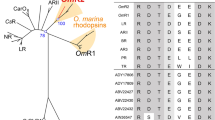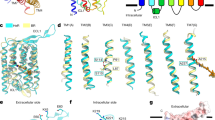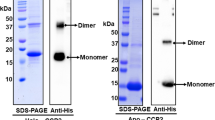Abstract
Aequorin is a calcium-sensitive photoprotein originally obtained from the jellyfish Aequorea aequorea1. Because it has a high sensitivity to calcium ions and is biologically harmless, aequorin is widely used as a probe to monitor intracellular levels of free calcium. The aequorin molecule contains four helix–loop–helix ‘EF-hand’ domains, of which three can bind calcium2. The molecule also contains coelenterazine as its chromophoric ligand3. When calcium is added, the protein complex decomposes into apoaequorin, coelenteramide and CO2, accompanied by the emission of light4. Apoaequorin can be regenerated into active aequorin in the absence of calcium by incubation with coelenterazine, oxygen and a thiol agent5. Cloning and expression of the complementary DNA for aequorin were first reported in 1985 (refs 2, 6), and growth of crystals of the recombinant protein has been described7; however, techniques have only recently been developed to prepare recombinant aequorin of the highest purity8, permitting a full crystallographic study. Here we report the structure of recombinant aequorin determined by X-ray crystallography. Aequorin is found to be a globular molecule containing a hydrophobic core cavity that accommodates the ligand coelenterazine-2-hydroperoxide. The structure shows protein components stabilizing the peroxide and suggests a mechanism by which calcium activation may occur.
This is a preview of subscription content, access via your institution
Access options
Subscribe to this journal
Receive 51 print issues and online access
$199.00 per year
only $3.90 per issue
Buy this article
- Purchase on Springer Link
- Instant access to full article PDF
Prices may be subject to local taxes which are calculated during checkout




Similar content being viewed by others
References
Shimomura, O., Johnson, F. H. & Saiga, Y. Extraction, purification and properties of aequorin, a bioluminescent protein from the luminous hydromedusan, Aequorea. J. Cell. Comp. Physiol. 59, 223– 240 (1962).
Inouye, S. et al. Cloning and sequence analysis of cDNA for the luminescent protein aequorin. Proc. Natl Acad. Sci. 82, 3145 –3158 (1985).
Shimomura, O. & Johnson, F. H. Peroxidized coelenterazine, the active group in the photoprotein aequorin. Proc. Natl Acad. Sci. USA 75, 2611–2615 ( 1978).
Shimomura, O. & Johnson, F. H. Chemical nature of light emitter in bioluminescence of aequorin. Tetrahedron Lett. 31 , 2963–2966 (1973).
Shimomura, O. & Johnson, F. H. Regeneration of the photoprotein aequorin. Nature 256, 236– 238 (1975).
Prasher, D., McCann, R. O. & Cormier, M. J. Cloning and expression of the cDNA coding for aequorin, a bioluminescent calcium-binding protein. Biochem. Biophys. Res. Commun. 126, 1259–1263 ( 1985).
Hannick, L. I., Prasher, D. C., Schultz, L. W., Deschamps, J. R. & Ward, K. B. Preparation and initial characterization of crystals of the photoprotein aequorin from Aequorea victoria. Proteins Struct. Funct. Genet. 15, 103–107 (1993).
Shimomura, O. & Inouye, S. The in situ regeneration and extraction of recombinant aequorin from Escherichia coli cells and the purification of extracted aequorin. Protein Expr. Purif. 16, 91–95 (1999).
Tanaka, T., Ames, J. B., Harvey, T. S., Stryer, L. & Ikura, M. Sequestration of the membrane-targeting myristoyl group of recoverin in the calcium-free state. Nature 376, 444–447 ( 1995).
Vijay-Kumar, S. & Cook, W. J. Structure of a sarcoplasmic calcium-binding protein from Nereis diversicolor refined at 2. 0 A resolution. J. Mol. Biol. 224, 413– 426 (1992).
Cook, W. J., Jeffrey, L. C., Cox, J. A. & Vijay-Kumar, S. Structure of a sarcoplasmic calcium-binding protein from amphioxus refined at 2. 4 Ångstroms resolution. J. Mol. Biol. 229 , 461–471 (1993).
Musicki, B., Kishi, Y. & Shimomura, O. Structure of functional part of photoprotein aequorin. J. Chem. Soc. Chem. Commun. 126, 1256– 1268 (1986).
Ohmiya, Y. & Tsuji, F. I. Bioluminescence of the Ca2+-binding photoprotein, aequorin, after histidine modification. FEBS Lett. 320, 267–270 (1993).
Ohmiya, Y., Ohashi, M. & Tsuji, F. I. Two excited states in aequorin bioluminescence induced by tryptophan modification. FEBS Lett. 301, 197–201 (1992).
Tsuji, F. I., Inouye, S., Goto, T. & Sakaki, Y. Site-specific mutagenesis of the calcium-binding photoprotein aequorin. Proc. Natl Acad. Sci. 83, 8107–8111 ( 1986).
Shimomura, O., Musicki, B. & Kishi, Y. Semi-synthetic aequorin. An improved tool for the measurement of calcium ion concentration. Biochem. J. 251, 405–410 (1988).
Shimomura, O., Musicki, B. & Kishi, Y. Semi-synthetic aequorins with improved sensitivity to Ca2+ ions. Biochem. J. 261, 913–920 (1989).
Shimomura, O., Inouye, S., Musicki, B. & Kishi, Y. Recombinant aequorin and recombinant semi-synthetic aequorins. Cellular Ca2+ ion indicators. Biochem. J. 270, 309– 312 (1990).
Shimomura, O. Luminescence of aequorin is triggered by the binding of two calcium ions. Biochem. Biophys. Res. Commun. 211, 359 –363 (1995).
Shimomura, O. & Inouye, S. Titration of recombinant aequorin with calcium chloride. Biochem. Biophys. Res. Commun. 221, 77–81 (1996).
Nomura, M., Inouye, S., Ohmiya, Y. & Tsuji, F. I. A C-terminal proline is required for bioluminescence of the Ca2+-binding photoprotein, aequorin. FEBS Lett. 295, 63–66 (1991).
Inouye, S., Aoyama, S., Miyata, T., Tsuji, F. I. & Sakaki, Y. Overexpression and purification of the recombinant Ca2+-binding protein, apoaequorin. J. Biochem. (Tokyo) 105, 473–477 (1989).
Otwinowski, Z. in Proceedings of the CCP4 Study Weekend: Data Collection and Processing. (eds Sawyers, L. Isaacs, N. & Bailey, S.) 56– 62 (SERC Daresbury Laboratory, Warrington, UK; 1993 ).
Terwilliger, T. C. & Berendzen, J. Automated structure solution for MIR and MAD. Acta Crystallogr. D 55, 849–861 (1999).
Collaborative Computational Project No. 4. The CCP4 suite: programs for protein crystallography. Acta Crystallogr. D 50, 760–763 ( 1994).
Jones, T. A., Zou, J. Y., Cowan, S. W. & Kjeldgaard, M. Improved methods for building protein models in electron density maps and the location of errors in these models. Acta Crystallogr. A 47, 110–119 (1991).
Brunger, A. T. et al. Crystallography & NMR system: A new software suite for macromolecular structure determination. Acta Crystallogr. D 54, 905–921 (1998).
Kleywegt, G. J. & Jones, T. A. Databases in protein crystallography. Acta Crystallogr. D 54, 1119–1131 (1998).
Guex, N. & Peitsch, M. C. SWISS-MODEL and the Swiss-PdbViewer: An environment for comparative protein modeling. Electrophoresis 18, 2714–2723 ( 1997).
POVRAY. Persistence of Vision Raytracer version 3. 1. 〈http://www.povray.org〉
Acknowledgements
We thank B. Kaminer for initiating this collaborative effort; B. Seaton for involvement in early crystallization studies; H. Nakamura for structural information on imidazopyrazinone; and the Boston University Mass Spectrometry Facility. This work was supported in part by NSF grants to O.S. and to J.F.H.
Author information
Authors and Affiliations
Corresponding author
Rights and permissions
About this article
Cite this article
Head, J., Inouye, S., Teranishi, K. et al. The crystal structure of the photoprotein aequorin at 2.3 Å resolution . Nature 405, 372–376 (2000). https://doi.org/10.1038/35012659
Received:
Accepted:
Issue Date:
DOI: https://doi.org/10.1038/35012659
This article is cited by
-
Longer characteristic wavelength in a novel engineered photoprotein Mnemiopsin 2
Photochemical & Photobiological Sciences (2022)
-
Reflecting on mutational and biophysical analysis of Gaussia princeps Luciferase from a structural perspective: a unique bioluminescent enzyme
Biophysical Reviews (2022)
-
Unusual shift in the visible absorption spectrum of an active ctenophore photoprotein elucidated by time-dependent density functional theory
Photochemical & Photobiological Sciences (2021)
-
Solution structure of Gaussia Luciferase with five disulfide bonds and identification of a putative coelenterazine binding cavity by heteronuclear NMR
Scientific Reports (2020)
-
Recombinant Ca2+-regulated photoproteins of ctenophores: current knowledge and application prospects
Applied Microbiology and Biotechnology (2019)
Comments
By submitting a comment you agree to abide by our Terms and Community Guidelines. If you find something abusive or that does not comply with our terms or guidelines please flag it as inappropriate.



